Roberto Gerhard was born to a French mother and a Catalan father on
25th September 1896 at Valls near Barcelona. He studied the piano
with Granados in Barcelona between 1915 and 1916 and composition with Felipe
Pedrell until the latter's death in 1922. Gerhard then travelled to Vienna
and on to Berlin, where he was a pupil of Schoenberg between 1923 and 1928
(significantly at a time when Schoenberg was formulating his 12-tone theory).
Franco took over Barcelona in 1938 and Gerhard, staying in Paris at the time,
determined not to return to his homeland. In 1939, with the help of his friend
Edward Dent, Professor of Music at Cambridge University, Gerhard moved to
Cambridge as a researcher and stayed there until his death on 5th
January 1970. His output includes ballet scores such as Don Quixote (1940)
and Pandora (1944) and an opera, The Duenna (1947) as well as chamber and
choral music. His four symphonies form the pinnacle of his orchestral output,
reflecting the influence of his teachers in that they combine Spanish rhythms
with serialism and a late-Expressionist use of the orchestra reminiscent
of the Second Viennese School. Gerhard's avoidance of traditional "themes"
makes his symphonies difficult to comprehend fully on first hearing, but
their well-honed beauty and craftsmanship does reveals itself to the listener
on closer acquaintance.
Symphony 'Homenaje a Pedrell' (1941)
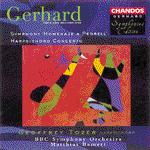
Though not part of the official Gerhard symphonic cycle, the Symphony 'Homage
a Pedrell' makes an excellent introduction to the symphonic writing of Roberto
Gerhard. Though the serialism of the later symphonies is absent, there is
a brilliance in the orchestration and a dark, eerie use of Spanish rhythms
and folksongs which is also to be found in the official canon. Bernard Benoliel
lists in the programme notes three reasons why he recommended the work to
be recorded as part of the Gerhard series on Chandos
(CHAN
9693): the first two movements were preserved as well as the Finale
which has been performed as a separate movement entitled "Pedrelliana"; cyclic
use of material from the first two movements is made in the Finale; and the
second movement's haunting beauty deserves to be heard. A couple more reasons
to record the complete work spring to mind: the first two movements are written
in such a way as to lead on to the next movement making a single structure
out of its three movements. Also, the ending of the symphony is so emphatic
and symphonic as to round off something much larger than just the 11-minute
Finale. The quality of the music is very high and could certainly win the
composer many new admirers, particularly those listeners who don't respond
to his later, more avant-garde works. The symphony breathes the same Catalan
air as his Don Quixote ballet music (1940) yet the influences of Sibelius
and Dvorak are to be found in the orchestration.
The opening Allegro (moderatamente) is Fantasy-like and is
Gerhard's most traditional-sounding symphonic movement. Its attractive themes
are taken from his teacher Felipe Pedrell's unperformed opera La celestina
(1904). Halfway through the movement, a Catalan song appears on oboe which
would be quoted in later Gerhard works, most movingly in the Fourth Symphony
of 1967.
The second movement is an expertly crafted Andante (un poco
adagio) which has a Nocturne-like quality about it. Gerhard's love of
early 20th Century French orchestral music is in evidence but
the movement also retains a uniquely Spanish flavour.
The Finale (Allegro giusto) is the symphony's most ambitious movement,
combining elements from the two preceding movements and adding syncopations
and complex percussion writing (two distinctive features of the official
Gerhard symphonic canon). The work ends darkly, reflecting the death of Pedrell
and perhaps also Gerhard's own feelings towards having to leave his homeland
and the uncertain future he faced in his adopted home.
Chandos have given the work a splendid recording which does full justice
to the wide ranging colours of this score and Mathias Bamert and the BBC
Symphony Orchestra are as impressive in this early example of Gerhard's symphonic
writing as they are in the later works. Their commitment and understanding
of the score means that "Homenaje a Pedrell" emerges as a satisfying achievement
in its own right rather than a piece of juvenilia of curiosity value only.
The coupling is the acerbic and atmospheric Harpsichord Concerto (1956) which
serves to introduce the listener to Gerhard's later style and features the
impressive musicianship of harpsichordist Geoffrey Tozer.
Symphony no 1 (1952-1953)
The First Symphony is dedicated to the composer's wife Poldi (1903-1994)
and received its first performance at the 1955 ISCM Festival in Baden-Baden
by the West German Radio Symphony Orchestra under Hans Rosbaud. It is scored
for flute, piccolo, oboe, cor anglais, 2 clarinets in B flat, 2 bassoons,
4 horns in F, 2 trumpets in C, 2 tenor trombones, tuba, timpani, percussion,
harp, pianoforte and strings. The typically expansive percussion section
(which was to increase still further in later symphonies) requires two players
and comprises 3 chinese tom-toms (small, medium and large), 2 suspended cymbals
(medium and large), side drum and tambourine in the hands of the first percussion
player. The second player looks after side drum, bass drum, 2 suspended cymbals
(medium and large), tam-tam, xylophone and 2 triangles (medium and small).
The first movement, a volatile eleven-minute Allegro animato opens
with a six bar introduction which contains a motto-like 12-note series divided
into two six note groups. The first group consists of a hushed descending
line from high to lower strings whilst the second group features woodwind
and brass in an ascending figure from the low register of the clarinet to
the high-pitched flute and piccolo, reaching a fortissimo peak. This
series creates a "V" shape and it is crucial to the development of the entire
symphony, acting as a kind of idée fixe. The staggered entry
of the partly divided strings results in a six-note held chord: thus, the
melodic line is self-harmonising. This preparatory six-bar introduction acts
as a huge upbeat launching the work and might even be regarded as a whole
exposition section in miniature since the remainder of the first movement
forms a realisation of the potential of these opening six bars.
The rest of the movement can be divided into five main sections. The first
of these starts at fig 1 of the score with a descending clarinet figure
interrupted by brass, percussion and strings before an insistent semiquaver
ostinati figure in upper strings leads off. The second section begins on
flute and piccolo four bars before fig 6 (poco piu mosso) and takes
the form of a traditional second subject. It is characterised by a certain
lyrical sweetness and delicacy reminiscent of the melodies of Schubert. After
a slight crescendo, there is a striking passage marked agitato (fig
7) whose brooding string chords sound like Bernard Herrman's score for the
soundtrack to Hitchcock's "Psycho" before the luckless heroine checks in
at the Bates motel. It is clear that something is going to happen and Gerhard
screws up the tension still further by reintroducing material from the first
section. Fierce tutti passages which sound (and look on the page of
the score) as if they might have been penned by Alban Berg soon disintegrate
into a disturbing oscillating triplet figure on the violins, eerily supported
by harp with its own ostinato figure (fig 16). This highly Expressionist
passage gives way to the third section marked scherzando which lightens
the mood. Its grace note and staccato markings create a slightly skittish
feeling although the threat of the previous tutti never seems far
away. Another striking passage marked agitato features tremolo
strings playing at the bridge of their instruments whilst harp and piano
punch out accented notes.
The penultimate section (fig 29) is set in motion by spiccato first
violins with another ostinato. It maintains the delicacy of mood
introduced by the scherzando but introduces a more emotionally detached tone
with its slightly academic-sounding fugal writing. The effect is not unlike
the "chamber music" sections in a late Mahler symphony as the strings (taking
centre stage for the first time in this work) weave their hushed and intricate
web of sound. As the woodwinds join the score at this point, the strings
set in motion a memorable passage where repeated chords sweep up and down
the section like regimented waves. This fanning out of string chords recalls
Stravinsky at his most rhythmically dynamic. The passage reaches a Bergian
climax with trumpet fanfares and leaping trombone calls before the coda is
ushered in on the tuba (four bars before fig 35). The tuba intones a three-note
phrase which becomes hypnotic, like a mantra, and is soon taken up by other
instruments. Other repeated phrases, including a recurring Hispanic six-note
motif assume prominence until the whole orchestra is furiously obsessed with
these brief scraps of theme. The movement ends abruptly on a sforzando
fortissimo chord with a strong sense of a musical argument postponed
rather than resolved.
The central Adagio is made up of five distinct sections, each with
its own character. The outer sections are slow and static whilst the inner
three are more lively. The first and last share material, as do the second
and fourth. The extended central section is the core of the movement and
the whole symphony.
The opening section juxtaposes long-held icy string chords with shorter woodwind
motifs. The sense of glacial calm is reminiscent of the opening of the slow
movement of George Lloyd's Fourth Symphony (1946). The second section begins
at one bar before fig 48 and is introduced by swirling semiquavers in the
strings. Playing at the bridge of their instruments, the strings create a
deliberately indistinct wash of sound. The central section (beginning at
fig 52) is scored mainly for strings with piano and harp and finds Gerhard
at his most Webernesque, every instrument's notes telling in the jewelled
orchestration. The chamber textures of this section are emphasised by the
concertante use of solo violin, viola and cello set against the rest
of the ensemble. The penultimate section (5 bars before fig 58) finds the
emotional level cranked up after the detached ruminations of the previous
passage. The twirling ponticello strings from the second section return briefly.
The last section (fig 66) returns to the steady tread of the movement's opening
bars. Two crescendos build up and subside before the Adagio closes
on a long single line for the double basses. So ends one of the composer's
most profound and personal utterances. It makes a strong case against those
who argue that atonal music lacks heart and soul.
The Allegro spiritoso Finale is the most substantial of the three
movements and continues the involved and involving arguments posited by the
opening Allegro animato. Its form is a microcosm of the whole symphony:
two fast sections encasing a slow hushed central one. The first section starts
with a bold introduction followed by a series of episodes which gather momentum
as the movement progresses. At fig 70, flutter-tongued flutes remind the
listener that Gerhard was a Schoenberg pupil: the nightmarish world of the
latter's Five Pieces for Orchestra of 1909 is strongly recalled. A quotation
from Beethoven's "Grosse Fugue" adds to the tension with its angular, loping
gait. A further ostinato on the flute is underpinned by string
glissandi (fig 76). More motifs ushered in on woodwind join in the
headlong rush (figs 80 and 87). The work becomes increasingly panic-stricken
and angry (one passage is marked furioso and reaches a crisis point
(fig 92). After a massive tutti crash, the piano carries on with an
eerie ostinato figure over disembodied string tremolos. The disconnected
piano writing here recalls John McCabe's use of otherworldly aleatoric piano
figures in his Concerto for Orchestra of 1982. Total silence reigns before
the calmness of the central section (fig 107) which explores the same
psychological terrain as the slow movement. The third section cuts in at
fig 118 and powers its way with relentless energy almost to the very end
of the symphony. The orchestra catches its breath at fig 151 and a gasping
chord leads to a rising woodwind figure over tremolo strings
sul ponticello. The symphony ends with a soft single held high
harmonic in the solo violin: the logical and moving conclusion to the movement's
spent force.
The first symphony was a turning point in the development of Gerhard as a
composer, breaking new ground in the development of the genre with its avoidance
of traditional "themes". The intense brooding passages of his opera "The
Duenna" and the Piano Concerto had pointed the way forward for Gerhard but
it is in the symphony that he fully flexes his post-Schoenbergian muscles.
It is fascinating to reflect that in Britain in the mid-1950s four ex-pupils
of Schoenberg were tackling the symphonic form with completely different
results: Hans Gál with his Late-Romantic Symphony no 3 (1952), Gerhard
with his serial/atonal Symphony no 1 (1953) and Egon Wellesz with his Brucknerian
Symphonies 3 (1951), 4 (1953) and, most Schoenbergian of all, no 5 (1956).
Karl Rankl's Symphony no 4 (1953) and 5 (1954) were written in Austria and
England, the Fifth Symphony displaying all the fastidious craftsmanship of
Schoenberg and occasionally sharing the soundworld of the older composer's
early works. Gerhard's First Symphony, for all its Expressionist leanings,
also displays its composer's Spanish origins in its hectic dance-like rhythms
which are often compressed into relentless ostinati. On a personal
level, Gerhard was recovering from a severe heart attack and some of the
mounting terror and anguish to be found in all three movements and the sense
of Destiny knocking at the door in his Symphony no 1 may result from this
near fatal experience. Julian White, in a fascinating and cogently argued
article in the March 1998 edition of The Musical Times draws attention
to the links between the Symphony and André Malraux's novel about
the Spanish Civil War, "L'Espoir". However, Gerhard himself was always at
pains to avoid any direct references to his inspirations in this Symphony:
"the music must be allowed to speak for itself", he wrote in the sleeve insert
to the Dorati recording. As purely objective music the piece retains its
power and originality unaided by any programmatic elements.
The work received its recording début with the BBC Symphony Orchestra
under Antal Dorati on a 1965 EMI LP (Stereo ASD 613/ Mono ALP 2063).
This performance is in many ways the best way to get to know the symphony
- Dorati brings the same understanding of the genre which he showed in his
recordings of the Second Viennese School released on the Mercury label. His
grasp of the work's highly original and organised structure is second to
none. The BBC Symphony Orchestra plays superbly and sounds very well rehearsed.
Unfortunately this LP, which also contained dances from Gerhard's Don Quixote
ballet music, is no longer available and has not been released on CD
(unaccountably).
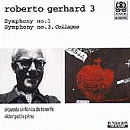
The Orquesta Sinfónica de Tenerife under Víctor Pablo Pérez
on the Auvidis Valois Montaigne label
(MO782103
coupled with symphony 3) present a more straightforward reading of the
work. Perhaps unsurprisingly, the Spanish elements in the symphony are brought
out in this version like no other and there is a freshness and spontaneity
about the performance which brings much pleasure. However, the standard of
orchestral playing is no match for either the BBCSO under Dorati or the same
orchestra 32 years later under Matthias Bamert on Chandos
(CHAN
9599). The strings are particularly vulnerable on the Valois disc,
sounding thin and emaciated beside the BBC players: in such important passages
as the opening of the central Adagio this makes for a disappointing
loss in atmosphere.
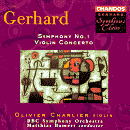
The Chandos disc provides a luxurious and detailed performance which carries
all before it. The many difficulties in the score are surmounted with graceful
ease by the BBC players, allowing the listener to concentrate purely on the
music: surely what the composer himself would have wanted. There is surprisingly
little difference between the interpretations or in the timings (perhaps
the composer's markings are so precise and well judged that there is little
room for conductors to impose their "personalities" too much on the music).
The Valois performance is slightly quicker than the Chandos in the first
two movements. However, the tempi are well judged by Bamert, so that the
many different sections of the three movements are given space to establish
their own unique atmosphere. The warm and full recording allows every marking
on this eventful and intricate score to tell. The couplings are significant:
on Valois, the Third Symphony brings the disc to a slightly meagre 59 minutes,
whilst the Chandos CD includes a beautifully realised account of the Gerhard
Violin Concerto bringing the disc up to over 75 minutes playing time. I have
no hesitation in recommending the Chandos disc but the Valois has its own
merits (the orchestral fallibility does give the performance an appropriately
edgy quality). The Dorati LP, should you come upon it in a second hand shop,
should be snapped up. It represents the conductor at his considerable best
and acts as a reminder that the BBCSO was always a virtuoso band with an
innate understanding of new and challenging scores. All three versions are
worth acquiring, but if pressed for a single choice, the Chandos would be
the one to have: Matthias Bamert displays a clear empathy with the score
and never allows any point-making to interfere with the architectural logic
of the symphony. His BBC players are poised and alert to the score's many
felicities and the sumptuous recording by Chandos is a pleasure in itself.
Symphony no 2 (1959)
The original version of the Second Symphony was written between February
1957 and the summer of 1959. It was commissioned by the BBC and dedicated
to the memory of the Catalan music patron Rafael Paxtot i Jubert. The symphony
was first performed by the BBC Symphony Orchestra under Rudolf Schwartz at
the Royal Festival Hall on 28th October 1959.
In 1967, following completion of his Fourth Symphony, Gerhard began a major
revision of his Second Symphony (which he now called "Metamorphosis")
on October 16th. The new version follows the same ground plan
as the original but involves a significant expansion of the orchestral forces
involved. It is scored for 2 piccolos, 2 flutes, 3 oboes, cor anglais, 2
clarinets, clarinet doubling bass clarinet, 3 bassoons, contra bassoon, 4
horns, 4 trumpets, 4 trombones, tuba, timpani, percussion, piano, accordion,
harp and strings. The percussion section (which is distributed amongst no
less than seven players) consists of: marimba, vibraphone, xylophone,
glockenspiel, small antique cymbals, 3 suspended cymbals, tambourine, claves,
castanets, bass drum, side drum, large tam-tam, 3 Chinese tom-toms, 7 wood
blocks, 5 Korean temple blocks, Latin American Timbales and a wooden scraper
with jingles.
By the end of January 1968 the composer had reached the last movement. After
writing 120 bars of this, he broke off to fulfil other commissions: the two
chamber works Libra and Leo and a Fifth Symphony. He did not resume work
on the revised score of the Second Symphony before his death on
5th January 1970. Alan Boustead prepared a performing version
and this was first performed in 1973 with the title "Metemorphosis". Alan
Boustead's version only includes the first 22 bars of the Finale and then
proceeds with the original 1959 version, leaving the listener to guess Gerhard's
final intentions for the ending of "Metamorphosis".
An important work in the development of the composer's late style, the original
version of the Second Symphony was his first major piece to incorporate a
12-note pitch series with a time-series controlling the work's duration and
entire structure. If, as a result of this attention to detail, the work may
strike some listeners as occasionally arid and lacking emotional involvement,
there is recompense to be had in the miraculous scoring and craftsmanship
in evidence.
The Symphony begins with a Poco sostenuto introduction which sets
out the 12-tone row each lasting for a different note value: the 12 values
on which the rest of the work is based. This introduction leads to a substantial
and driving Allegro assai which launches the main section of the movement.
The tempo is slowed down twice in the course of the movement. The first slower
passage, featuring all the percussion players, begins at fig 16 (Track 15
on the Valois CD). The second slower passage is characterised by brass and
percussion (fig 23). This leads to a faster section marked Poco piu
animato at fig 36 (Track 16). The first violins have a Pyscho-like stabbing
passage at fig 39 which grabs the attention and the way is prepared for a
decisive climax in rhythmic stretto at fig 44.
The second part of the Symphony begins Lento at fig 49 (Track 17)
with the thrilling sound of twelve clicking wood-blocks played by all
percussionists sounding like a plague of giant crickets. This extraordinary
sound was inspired by noises from a field whilst the composer was waiting
for a bus on holiday in Majorca. There is a Scherzo-like Comodamente
interlude at fig 72 (Track 18) whose easy-going mood lightens the mood of
the work. Somewhere past its midway point (fig 84), the wood-blocks fade
out to leave the more lyrical material to form a bridge passage to the Finale.
The molto vivace final span begins at fig 90 (Track 19) with the sound
of seven cymbals and continues in the form of a sparsely-scored nightmarish
waltz in the spirit if not the manner of a middle movement of a late Mahler
symphony. A passage of spiccato writing catches the ear (five bars
after fig 106) and the actual mid-point of the finale occurs at fig 108 (Track
20) with two bars of tom-tom. The waltz is cast in the form of a palindrome
and so the movement retraces its steps and thus the last sounds of the symphony
are of the glimmering cymbals with which the finale began.
The original Second Symphony is an impressive achievement, although it is
hard not to see it as a transitional work between the superior First and
Third Symphonies. It seems almost regrettable that the composer should have
deemed it necessary to tamper with it eight years after its first performance.
This is certainly the view of Bernard Benoliel, who, in his programme notes
to the Chandos release of the 1959 work, makes a very eloquent case for the
original version to take precedence over "Metamorphosis". The Chandos performance
also adds weight to this argument as the textures are much cleaner than in
the Valois recording, though the performance of the revised Second Symphony
is one of the finest in the Auvidis Valois cycle. Both versions are worth
acquiring not only for the quality of the performances but also because they
are in essence two different works, the additional instruments in "Metamorphosis"
changing the character of the symphony quite significantly.
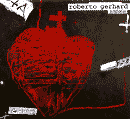
The Chandos release
(CHAN
9694) featuring the BBC Symphony Orchestra under Matthias Bamert
couples the original version of Symphony no 2 with the magnificent Concerto
for Orchestra: a full-blooded late work in Gerhard's most extrovert and confident
vein, whilst the Auvidis Valois CD (
MONTAIGNE
MO 782102) with the Orquesta Sinfónica de Tenerife under
Víctor Pablo Pérez couples Metamorphosis with Gerhard's "New
York" Symphony (no 4).
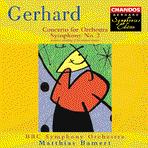
It must be said that the Second is the most problematic of the Gerhard symphonies
and I find it occasionally guilty of a passionless anonymity not to be found
elsewhere in the cycle. It is certainly not the place to start an investigation
of this composer's symphonic output.
Symphony No 3 (Collages) (1960)
The Third Symphony was commissioned by the Koussevitzky Foundation and dedicated
to the memory of Serge and Natalie Koussevitzky. It received its first
performance on 8 February 1961 at the Royal Festival Hall by the BBC Symphony
Orchestra under Rudolph Schwartz. The BBC SO also recorded the work for EMI
with the conductor Frederik Prausnitz on a long-deleted LP (ASD 2427). The
work is scored for 2 flutes (doubling piccolos), piccolo, 3 oboes
(3rd doubling cor anglais), 3 clarinets in A (3rd doubling
bass clarinet), 2 bassoons, double bassoon, 4 horns, 3 trumpets in C, 2
trombones, bass trombone, tuba, timpani, harp, piano, electronic tape, strings
and an enormous percussion section: large suspended cymbal, 3 Chinese tomtoms
(large, medium, small), large antique cymbal, maracas, side drum, wood blocks
(large and small) (player one); tam tam, bass drum (player two); xylo-rimba,
glockenspiel (player three); vibraphone (player four); marimba (player five).
The work encompasses the span of one day from dawn to the dead of night and
is cast in seven continuous sections which contrast in design, texture, tempo
and mood. The subtitle "Collages" refers to the prominent role given to
electronic tape which sounds alongside the "musical" sounds of the orchestra.
The sounds of the tape are indeterminate and vary in pitch, producing a unique
combination of music and controlled "noise" which, according to the composer,
was "a gamble, a real adventure into the unknown". The original idea for
the work occurred to Gerhard whilst he was on a return flight from America
and flying at about 30,000 feet over the Irish coast, he saw the sun rise
"like the blast of 10,000 trumpets". This fantastic image sparked the composer's
imagination and the idea of travelling in a jet-plane suggested the use of
electronic tape (the first sounds from the tape at the start of the symphony
actually sound like a jet).
The first movement is an Allegro moderato which describes the image
of the rising sun by the use of an opening blast of three unison trumpets.
A series of built up chords from individual notes spread throughout the large
orchestra creates a feeling of expectancy and opens up wide vistas in the
manner of Copland's "outdoor" style. Wide leaps in the strings are echoed
in the woodwind and the section dies away on a triple piano chord.
The following Lento suggests the landing of the jet or coming down
to earth, though not as literally as in the conclusion of Ian Parrott's Second
Symphony (1960), also inspired by airplane travel. The section also represents
the world of plant life in all its variety. It begins on a fortissimo
arpeggiated figure for first violins over a loud chord from the piano. Soon
an ostinato figure is set up on marimba, joined by piano, xylo-rimba
and first violins. The score becomes Webernesque with spare harmonics dotted
about the page and telling col legno taps from the double basses.
A marimba ostinato leads directly to the next section.
The Allegro con brio is the most extended section in the symphony.
It represents the "world of man, with the darkness at noon, with his despair,
his rage, his pity, his defeat". The nature of the music is violent and restless
with crashing harmonic rolls on the timpani, metallic strokes from the
glockenspiel and piano and furious pizzicati from the strings. A quieter
section at fig 11 recalls the mood of the opening of the symphony but it
is interrupted and a huge climax ensues. After this, a passage marked "steady"
initiates a machine-like sequence in which pizzicato strings,
staccato woodwind, brass, percussion and piano exhaust themselves
in a grotesque doll-like procession. After another pause and a further
machine-like sequence, a series of crescendos presages the central
Moderato section.
This section is the only one to avoid the use of electronic tape. It is meant
to represent what goes on in the mind of someone who has lost consciousness.
Beginning with a cluster on the piano, the section consists of a series of
delicate chords built up from widely spaced notes throughout the orchestral
palette. Building on Schoenberg's "Klangfarbenmelodie" (or endless melody)
where the theme is endlessly shared between different instruments producing
a kaleidoscopically changing series of colours, this passage is hypnotic
and beautiful, providing a welcome still centre to the symphony.
The following Vivace is a sort of "coming to" from an anaesthetic
with a woozy feeling this induces as an after-effect. Underlying this section
is the ghost or memory of a Spanish dance rhythm much as the ghost of a Viennese
waltz haunts Ravel's "La Valse". It is perhaps not too fanciful to imagine
the unconsciousness of the previous movement to represent the composer's
own artistic block when he came to England as an exile. The "coming to" might
be regarded as nostalgia for his homeland (the first piece he began working
on when he settled in Britain was "Don Quixote", one of his most overtly
"Spanish" compositions). In any event the use of Latin rhythms in a work
which is otherwise so abstract is very striking and gives this section a
uniquely recuperative flavour after the stasis of the previous
Moderato.
The ensuing Allegretto recalls the music and events of the
Lento second section. Gerhard here imagined lights turning on in distant
cities and there is a "winding down" feeling to the section. It its centre,
it includes a sort of "cadenza" for electronic tape which has always sounded
together with the orchestra up to this point. Gradually the orchestra reassembles
and prepares for the concluding Calmo.
This last section conveys the stillness at dead of night. The objective mood
of much of the work grows into something more subjective. The composer has
said that the closing bars, which are very moving indeed, were written very
much "in the first person singular".
Monumental in a Sibelian way, this is perhaps Gerhard's "Pastoral" Symphony
with its allusions to Nature. It is also a hymn of praise and is related
to Psalm 113 verse 3: "From the riding of the sun unto the going down of
the same may the Lord's name be praised". The work also relates to the different
times of the day and the colours of the spectrum (thus the third section
is a reference to "Darkness at Noon" by Arthur Koestler. The use of electronic
tape goes one further than Varèse, who juxtaposed tape and orchestral
textures in his Déserts of 1954: getting the balance right between
tape and orchestra in "Collages" is just one of the many difficulties facing
the conductor of this epic and challenging work.
There are currently two CD versions available of this work. One features
the Orquesta Sinfónica de Tenerife under Víctor Pablo Pérez
on Auvidis Valois Montaigne
(MO782103
coupled with symphony 1) in a 1993 recording and the BBC Symphony Orchestra
conducted by Matthias Bamert on Chandos
(CHAN
9556) in a reading set down in early 1997. The original LP version
with the BBC Symphony Orchestra under Frederik Prausnitz on EMI (ASD
2427) is also worth getting hold of via second hand dealers - the playing
of the BBC orchestra is astonishingly good but the contribution of the tape
is very intrusive and at times unintentionally comic. The BBC Radiophonic
Workshop contributed the sounds for the original tape and at times on the
EMI LP one is inescapably reminded of the soundtrack to an early Doctor Who
episode or Quatermass and the Pit, both productions for whom the BBC Radiophonic
Workshop provided atmospheric soundtracks.
The Auvidis Valois CD is also rather generous in its use of the tape,
occasionally drowning out the rest of the ensemble. The strings are very
thin in places (a problem with this Gerhard Symphony series generally) ie
the arpeggio figure initiating the Lento section scored for
first violins sounds suspiciously like a solo violin and the staccatissimo
passage for divided strings before the Allegretto section) sounds
more like a string quartet! Otherwise, the reading sounds well prepared and
the "Spanish" rhythms of the Vivace sound crisply authentic. This
is very much a performance in the cold light of day with not too much light
and shade or inner landscape about it. For that one must turn to the Chandos
version.
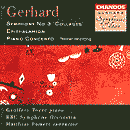
Again, the Chandos reading has the edge on its rivals with phenomenally accurate
orchestral playing allied to a genuine interpretation on the part of Bamert.
The subtle use of the tape (which today sounds stubbornly rooted in the early
1960s) enhances the score, adding extra depth to the palette rather than
talking over the symphony completely as it threatens to do in the Auvidis
Valois performance and does in the EMI version. Couplings are important too
with a work which lasts only 20 minutes: Chandos give us the premiere recording
of the Gerhard Piano Concerto followed by a splendid performance of the great
late orchestral work "Epithalmion", whilst the Valois disc is coupled with
the Symphony no 1. In sum, the Chandos is the version to have but the EMI
LP is certainly of more than mere curiosity value if you can put up with
the gurglings of the closely-miked electronic tape.
Symphony no 4 "New York" (1967)
The Fourth Symphony was commissioned by the New York Philharmonic Orchestra
for its 125th Anniversary. It received its world première
on 14th December 1967 in New York given by the NYPO conducted
by William Steinberg. The European première took place on
27th October 1968 by the Stockholm PO under Antal Dorati and the
English première was on 4th December 1968 at the Royal
Festival Hall with Colin Davis conducting the BBC Symphony Orchestra at a
concert of the Royal Philharmonic Society.
The symphony is one its composer's most massive statements and calls for
a huge orchestra: 4 flutes (3rd and 4th doubling piccolos),
4 oboes, 4 clarinets in A, 3 bassoons, 1 double bassoon, 6 horns in F, 4
trumpets in C, 3 tenor trombones, 1 bass trombone, 1 tuba, 2 harps, celeste,
piano, 4 pedal-timpani, percussion and strings. The percussion section is
huge even by Gerhard's standards:
Player one: glockenspiel, 2 suspended cymbals, 2 Chinese wood-blocks, 2
tambourines, 1 pair of antique cymbals
Player two: vibraphone, 2 suspended cymbals, Latin-American Timbale, Latin
American Timbale and snareless Caisse Claire, 2 tambourines, triangle, 2
Chinese wood-blocks, large Chinese tom-tom, side drum
Player three: xylophone, 2 suspended cymbals, 3 chinese tom-toms, tambourine,
Chinese wood-block, claves, 1 tubular bell
Player four: marimba, 2 suspended cymbals, large tam-tam, set of 11 tubular
bells, 2 korean temple-blocks, tambourine, Chinese wood-block, bass drum
Gerhard's Symphony no 4 is a powerful one-movement structure which arguably
carries on from where the composer's Concerto for Orchestra of 1965 left
off: in many ways the Fourth is itself a concerto for orchestra and the score
contains one of highest levels of virtuosity demanded by any symphonic work.
The work begins with a series of chord clusters which are dragged upwards
by the clarinets (fig 1 and Track 1 of the Valois CD). A section with spiky,
angular string writing follows (fig 4) and this is succeeded by a remarkable
passage with Spanish fanfares and guitar-like strumming (fig 5). Here Gerhard
remembers his Catalan roots but the Latin motifs are refracted through the
avant-garde sounds of the 1960s as if memory has distorted something once
familiar. Echoing clusters of string harmonics appear at fig 10 before a
striking section begun by a loping percussion figure initiated by the marimba
(fig 11, Track 2). A scherzando episode lightens the atmosphere (molto
vivace, con impeto: 2 bars before fig 21, Track 3). A ghost of a slow
movement appears 8 bars before fig 25 (Track 4) as a deliberate series of
resonating chords which anchor the piece to the pitch E. This leads to a
rich passage for divided strings that provides the work's slowly-beating
heart (fig 28). An Allegro section bursts in at 1 bar before before
fig 32 (Track 5), building to a piano cadenza which begins 1 bar before fig
38, leading to a brief moment of stasis at fig 39. A new episode, fantastic
and fleet of foot, begins at fig 40 (Track 6), marked flessibile and
a series of bell-like chimes appears at fig 46 (Track 7). An important de
Falla-like trumpet fanfare motif cuts in at fig 52 (Track 8) and starts to
dominate the texture. Timpani glissandi (fig 68, Track 9) lead to
a passage where the oboes have a poignant duet on an ancient Catalan folksong
(the same folksong which appeared in the first movement of Gerhard's "Homenaje
a Pedrell" Symphony) (fig 70). Faster music begins (deciso at fig
73, Track 10). The tempo reaches an Allegro con moto (Track 11) and
the symphony's expressive culmination takes place at fig 92 (Track 12) before
the work proceeds smartly to a vehement conclusion (1 bar before fig 106,
Track 13).
The Fourth Symphony was first recorded by Sir Colin Davis and the BBC Symphony
orchestra on the Argo label for Decca (ZRG 701) on a
now-deleted LP in 1972. To my ears there is a surprising lack of feeling
and empathy with the music in this reading considering the forces involved
had given the English premiere of the work. The quicker sections seem rushed
and harried whilst the more reflective episodes do not dig deep
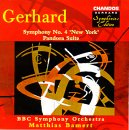
enough under the surface of this music as the Chandos version with
Matthias Bamert and the BBC Symphony Orchestra do so splendidly
(CHAN
9651). The Auvidis Montaigne CD version
(Montaigne
MO 782102) with the Orquesta Sinfónica de Tenerife is not
so far behind in terms of interpretation, conductor Víctor Pablo
Pérez turning in his most impressive reading of a Gerhard symphony
with the Fourth. However, the limitations of the Tenerife orchestra are revealed
even more in such a virtuosic work, the strings in particular seeming paper
thin in comparison with the lush BBC section. Matthias Bamert reserves his
most penetrating conducting for this very moving work and the superbly played
Pandora Suite makes a delightful, if not over-generous, coupling.
In sum, the Chandos Gerhard Symphony series is almost self-recommending.
The BBC Symphony Orchestra is perhaps a key to the success of the enterprise:
the orchestra's involvement with Roberto Gerhard goes back to the first
performances and recordings of many of the works on these CDs and Matthias
Bamert makes a sympathetic and at times inspired conductor of these brilliantly
orchestrated symphonies. The Auvidis Montaigne CDs are less polished and
the playing is not in the same league as the BBC players for Chandos and
yet there are occasional insights to be gained from the Tenerife versions
of the works, not least an authentically Spanish flavour to the readings.
Of the LPs, Antal Dorati's recording of Symphony no 1 is well worth tracking
down from second hand shops: it exudes the excitement of new discovery and
has the advantage of a world class conductor bringing all his intellect and
flair to bear on the piece.
Chandos are to be congratulated on their excellent Gerhard Symphonies Edition
and I hope they will bring their attention to other émigré
symphonists such as Wellesz, Rankl, Gál, Joubert, Williamson and Panufnik
in the near future.
As a cheaper alternative symphonies 1-4 are available on a 2CD set on
Auvidis Montaigne
MO782113
£12.50
Paul Conway
